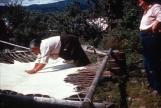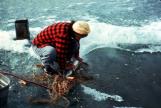14
Jim Fox using awl to make hole in snowshoe frame for webbing.
11 July 1949
Teslin Region

15
Babiche for lacing and patterned webbing (e.g., for snowshoes) was taken from moosehide. Women or children would cut three long strips from a wet hide by following a large circular cut in a snailshell effect.
16
Annie Geddes tests the tautness of a moose hide in its frame.
July, 1949
Teslin Region

17
Routine work for women included cleaning and tanning furs and hides, making sinew footwear, bags and clothing, and repairing tents.
18
Beaver net stretched out in front of house.
1948
Teslin, Yukon

19
In the period before guns, the Tlingit used nets and spears for beaver hunting. In early spring or late fall, nets were placed just outside the beaver lodge at a known entry point. Nets were also placed away from the lodges where channels merged into rivers.
20
Detail of end pole of beaver net, with antler toggle and moose hoof rattles.
May, 1951
Teslin, Yukon

21
Nets were made of moose or caribou hide babiche, loosely webbed. Small bells made of caribou hoof were sometimes attached. The hooves rattled when the net was agitated.
22
Mable Johnston ice fishing.
May, 1951
Teslin, Yukon

23
The Tlingit people used sinew or willow-bark gill nets for fishing. The women would hold netting parties, preparing the sinew by rolling it in their palms and on their thighs. They made the sinew soft and stretchable by moistening it in their mouths.
24
Two boys sit among furs.
1938
Johnstontown, B.C.

25
In the past, most Tlingits began to trap around age 8 and continued into their 70s and 80s. Each member of a family had their own trapline or traps. Entire families trapped adjacent to one another.
26
Lynx pelts at Johnstontown.
1940
Johnstontown, B.C.

27
Trapping supplied food and hide, and an opportunity to trade or sell. It was pursued as an unquestioned traditional use of the land and as an act of appreciation for the land's bounty.






